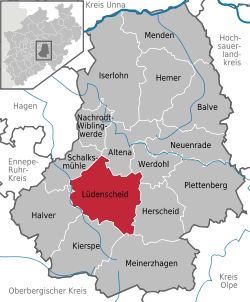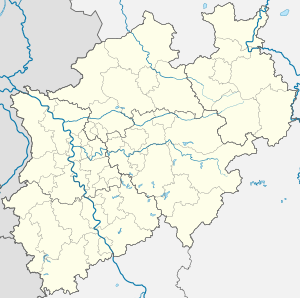Lüdenscheid
Lüdenscheid (German pronunciation: [ˈly:dn̩ʃaɪt]) is a city in the Märkischer Kreis district, in North Rhine-Westphalia, Germany. It is located in the Sauerland region.
Lüdenscheid | |
|---|---|
Town hall of Lüdenscheid | |
 Coat of arms | |
Location of Lüdenscheid within Märkischer Kreis district  | |
 Lüdenscheid  Lüdenscheid | |
| Coordinates: 51°13′N 07°38′E | |
| Country | Germany |
| State | North Rhine-Westphalia |
| Admin. region | Arnsberg |
| District | Märkischer Kreis |
| Government | |
| • Mayor | Dieter Dzewas (SPD) |
| Area | |
| • Total | 86.73 km2 (33.49 sq mi) |
| Highest elevation | 539 m (1,768 ft) |
| Lowest elevation | 232 m (761 ft) |
| Population (2018-12-31)[1] | |
| • Total | 72,611 |
| • Density | 840/km2 (2,200/sq mi) |
| Time zone | CET/CEST (UTC+1/+2) |
| Postal codes | 58507–58515 |
| Dialling codes | 02351 |
| Vehicle registration | MK LÜD (until 1974) LS (until 1979) |
| Website | www.luedenscheid.de |


Geography
Lüdenscheid is located on the saddle of the watershed between the Lenne and Volme rivers which both empty into the Ruhr river (which subsequently flows into the Rhine), with three smaller valleys leading to them. The saddle has a height of 420 meters, higher elevations on the watershed are an unnamed hilltop of 505 meters in the north, and the 663 meters high Nordhelle in the Ebbegebirge mountain range. In the surrounding mountainous area, six dams created reservoirs to regulate the water flow in the Ruhr river and supply drinking water. The mountainous nature of the city's territory gave rise to the nickname "Bergstadt" (mountain town). The original settlement circles around the church built on a ledge of the slope above the saddle.
| Largest groups of foreign residents | |
| Nationality | Population (2011) |
|---|---|
| 3,115 | |
| 2,858 | |
| 906 | |
History
While first settlement in the Lüdenscheid area is confirmed for the 9th century, the first mention of the place as a village was made in 1067 and as a city in 1268. In the 15th and 16th century Lüdenscheid was a member of the Hanseatic League. Since 1609 the town belonged to the Electorate of Brandenburg, the later Prussia. In 1815 it became part of the new Prussian Province of Westphalia, and 1975, with the creation of the Märkischer Kreis, became seat of its administration. In 1898 the aluminium framework of the first Zeppelin airship was built in the factory of Carl Berg in Lüdenscheid.
Economy
Lüdenscheid is a predominantly industrial town with small and medium-sized firms in the metal and plastics industry. The largest company employs 2000 people in Lüdenscheid, with other firms employing 800 people or less.
The economic importance came to the fore in the Middle Ages, when the town became a centre for metal ore mining in the surrounding area, through the ("osemund"/osmond iron). The ore was processed by the hammers and wire drawers o Lüdenscheid, serviced by water power in the surrounding valleys. A number of artisanal smitheries in Lüdenscheid made finished products out of those materials. In order to market these products to a wider area, Lüdenscheid joined the Hanseatic League.
With the emergence of the industrial age, the production of buttons and buckles played a large role, reflected in the "Knopfmuseum" (Button museum). Later, new materials like aluminium, bakelite, and plastics were adopted. A supporting industry producing the forms for the stamping, blanking, pressing and casting emerged and still plays an important part in Lüdenscheid's industry.
Production of parts of the auto industry and of fittings for electrical installations play an important role as well as continuous casting of aluminium profiles. Products notable to end consumers are lamps and lighting systems and toys.
Education
One of the five branches of South Westphalia University of Applied Sciences is in Lüdenscheid. See also the Fachhochschule Südwestfalen (FH SWF)), which offers various engineering programmes and is located in the city.
Places of interest
- Erlöserkirche (Church of the Redeemer)
- in the center of the circular layout of the old city. The protestant church is the oldest in the town. Its tower dates from the 11th century, while the parish nave was rebuilt during the classicistic period in the early 19th century.
- Water castle Neuenhof
- in the Elspe valley behind the Nurre mountain. The present building with an early baroque style was erected in the end of the 17th century.
- Homert tower
- Observation tower on top of the Homert mountain (539 m above sea level), the highest location in Lüdenscheid
- Versetalsperre (River "Verse" reservoir)
- City Museum
- including among others the Knopfmuseum (Button museum) and other exhibits showing the evolution of Lüdenscheid's industry
Coat of arms
The coat of arms shows Saint Medardus as the patron of the city. Below it has the red-and-white checked fess from the arms of the Counts of the Mark. The city wall at the bottom denotes the city rights that Lüdenscheid received in 1287.
Sports
"Lüdenscheid-Nord" is a demeaning and satirical name, most commonly used by the fans of FC Schalke 04 to mock the football club Borussia Dortmund. The real football club Rot-Weiß Lüdenscheid is playing in the Bezirksliga, the eight level below the Bundesliga, but did play once in the second Bundesliga Nord (Northern section) for two seasons in 1977–78 and 1978–79.
The Highlander Lüdenscheid are a skaterhockey-team playing in the highest German league, the Bundesliga.
International relations
Lüdenscheid is twinned with:[2]


.svg.png)



Personalities
- Carl Berg, airship builder
- Else Hueck-Dehio, writer
- Kurt Weill, the composer had his first engagement from 1919–1921 at the theatre in Lüdenscheid.
- Paul Wieghardt, the painter was born in Lüdenscheid.
- Wilhelm Ackermann, mathematician.
- Nuri Şahin, Werder Bremen midfielder was born in Lüdenscheid.
- Adolf Schulte, World War I flying ace was born in Lüdenscheid.
Media
One of Lüdenscheid's newspapers is the Lüdenscheider Nachrichten with its Süderländer Volksfreund.
References
- "Bevölkerung der Gemeinden Nordrhein-Westfalens am 31. Dezember 2018" (in German). Landesbetrieb Information und Technik NRW. Retrieved 10 July 2019.
- "Lüdenscheids Partnerstädte". luedenscheid.de (in German). Lüdenscheid. Retrieved 2019-11-27.
